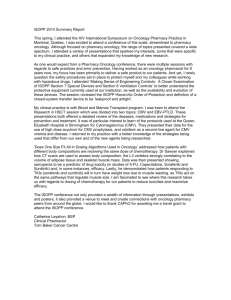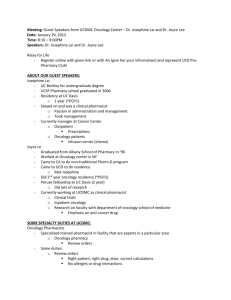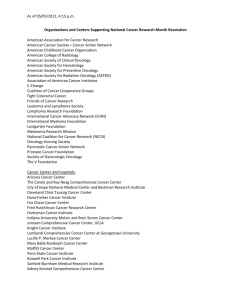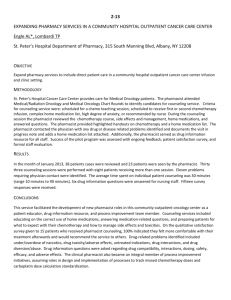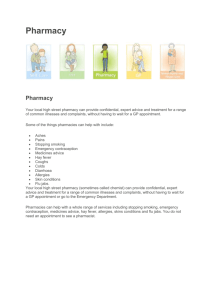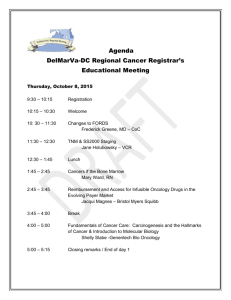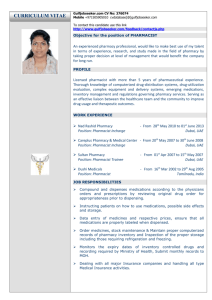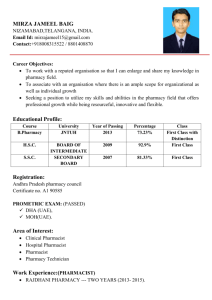Background
advertisement
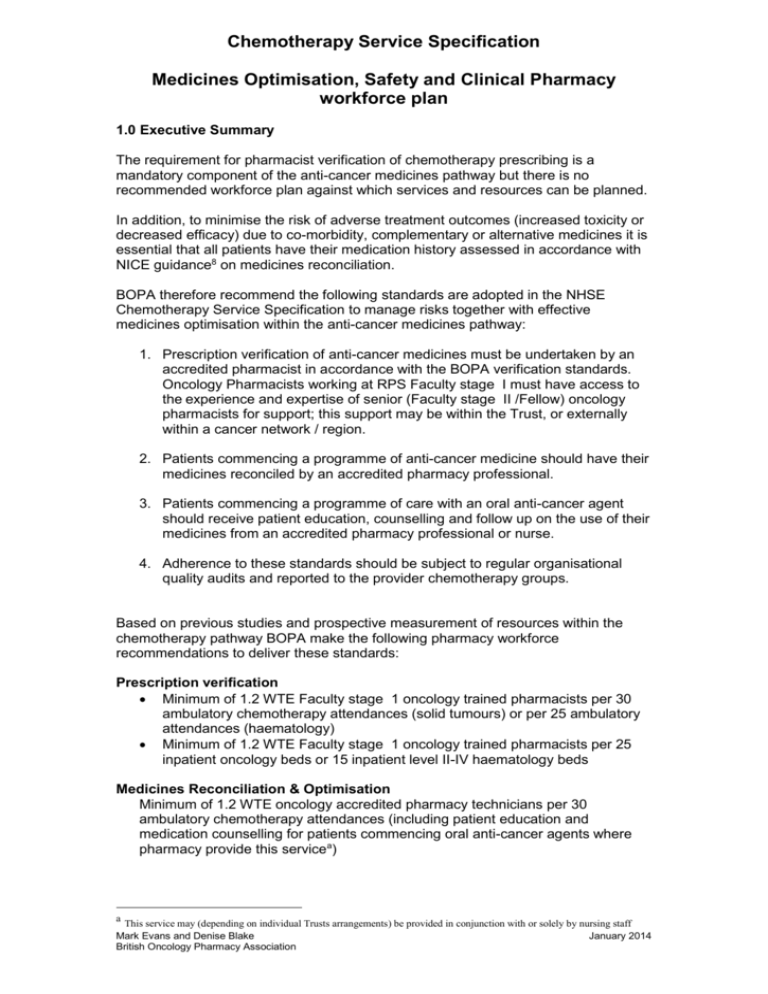
Chemotherapy Service Specification Medicines Optimisation, Safety and Clinical Pharmacy workforce plan 1.0 Executive Summary The requirement for pharmacist verification of chemotherapy prescribing is a mandatory component of the anti-cancer medicines pathway but there is no recommended workforce plan against which services and resources can be planned. In addition, to minimise the risk of adverse treatment outcomes (increased toxicity or decreased efficacy) due to co-morbidity, complementary or alternative medicines it is essential that all patients have their medication history assessed in accordance with NICE guidance8 on medicines reconciliation. BOPA therefore recommend the following standards are adopted in the NHSE Chemotherapy Service Specification to manage risks together with effective medicines optimisation within the anti-cancer medicines pathway: 1. Prescription verification of anti-cancer medicines must be undertaken by an accredited pharmacist in accordance with the BOPA verification standards. Oncology Pharmacists working at RPS Faculty stage I must have access to the experience and expertise of senior (Faculty stage II /Fellow) oncology pharmacists for support; this support may be within the Trust, or externally within a cancer network / region. 2. Patients commencing a programme of anti-cancer medicine should have their medicines reconciled by an accredited pharmacy professional. 3. Patients commencing a programme of care with an oral anti-cancer agent should receive patient education, counselling and follow up on the use of their medicines from an accredited pharmacy professional or nurse. 4. Adherence to these standards should be subject to regular organisational quality audits and reported to the provider chemotherapy groups. Based on previous studies and prospective measurement of resources within the chemotherapy pathway BOPA make the following pharmacy workforce recommendations to deliver these standards: Prescription verification Minimum of 1.2 WTE Faculty stage 1 oncology trained pharmacists per 30 ambulatory chemotherapy attendances (solid tumours) or per 25 ambulatory attendances (haematology) Minimum of 1.2 WTE Faculty stage 1 oncology trained pharmacists per 25 inpatient oncology beds or 15 inpatient level II-IV haematology beds Medicines Reconciliation & Optimisation Minimum of 1.2 WTE oncology accredited pharmacy technicians per 30 ambulatory chemotherapy attendances (including patient education and medication counselling for patients commencing oral anti-cancer agents where pharmacy provide this servicea) a This service may (depending on individual Trusts arrangements) be provided in conjunction with or solely by nursing staff Mark Evans and Denise Blake January 2014 British Oncology Pharmacy Association 2.0 Background 2.1 Pharmacist review and verification The role of the clinical oncology pharmacist in reducing risk in the chemotherapy pathway is well developed and described in the UK. The NCAG report (2009)1 stated ‘All chemotherapy prescriptions should be checked by an oncology pharmacist, who has undergone specialist training, demonstrated their appropriate competence and is locally authorised/ accredited for the task’2 BOPA subsequently described the role of the pharmacist in verification of anticancer prescriptions within the ‘Standards for Pharmacy Verification of Prescriptions for Cancer Medicines’ in 2010, and updated in 20133. This document described all the checks recommended for clinical pharmacists to adequately assess the appropriateness of anti-cancer medications for patients as part of the governance framework. A recent review of prescribing of chemotherapy against the BOPA standards in England, Scotland and Wales identified that 2.3% of prescriptions contain an error detected in the verification process which could result in medical intervention or hospitalisation and 0.3% could result in a potentially fatal event4. The national service specification5 developed by the Chemotherapy Clinical Reference Group (CRG) states that ‘the provider service will need to ensure sufficient oncology pharmacists and technical pharmacy staff for the checking of prescriptions, reconstitution and delivery of drugs’. With the requirement for pharmacist verification a mandatory component of the anti-cancer medicines pathway, there needs to be adequate and consistent pharmacy resource in place to deliver a safe, effective and timely service. Although the requirement for pharmacist verification of chemotherapy prescribing is a mandatory component of the anti-cancer medicines pathway, there is no national workforce plan in NHS England for oncology pharmacists to undertake the role of prescription verification. BOPA has agreed to work with the CRG to develop workforce recommendations to ensure delivery of safe and consistent anti-cancer therapy services across NHS England. 2.2 Medicines Optimisation The anti-cancer therapy landscape has changed significantly over the last 5-10 years and is continuing to develop with advent of more sophisticated genetic profiling and personalised medicine. These changes have introduced an increase in the use of anti-cancer agents, particularly oral therapies with different and more diverse toxicity profiles to conventional chemotherapy. The use of these medicines needs to be optimised to ensure patients receive maximal benefit. Such medicines often have a narrow therapeutic window and have significant patient-drug, herbal-drug and drugdrug interactions6. Due to the age related incidence of cancer, patients often have co-morbidities requiring medication and consequently are at high risk of clinically meaningful drug – drug interactions7. Studies have also demonstrated a high use of complementary and alternative medicines (CAM) in cancer patients8, and consequently a high risk of interaction with conventional anti-cancer therapy9. It is therefore essential to minimise the risk of adverse treatment outcomes (increased toxicity or decreased efficacy) that all patients commencing a new programme of anti-cancer therapy have their medication history assessed by a competent healthcare professional. In accordance with NICE guidance10 on medicines reconciliation for adult patients admitted to hospital, it is recommended Mark Evans and Denise Blake British Oncology Pharmacy Association January 2014 that this is undertaken by a pharmacy professional; in many cancer care pathways this would ideally form part of the pre-chemotherapy assessment. There has been a shift of activity for chemotherapy administration to the outpatient or day care setting, from the inpatient setting over recent years. The recent review of prescribing of chemotherapy in England, Scotland and Wales found that 7.5% of prescribing of SACT was for inpatients, 55.2% for day cases and 37.3% for outpatients. All patients receiving oral anti-cancer agents should receive patient education / counselling on the use of their medications at the start of treatment 10. This task is most commonly undertaken by a pharmacy professional or a chemotherapy nurse, depending on the pathway at individual institutions. Where patients are receiving education on the use of their oral anti-cancer therapy, it is important that staff are accredited to undertake this task. It is also important that information is provided in a robust and consistent manner using validated tools e.g. MASCC Oral Agent Teaching Tool12. 3.0 Oncology Medicines Optimisation and Safety Standards BOPA recommend the following Medicines Optimisation and Safety Standards are adopted in the Chemotherapy Service Specification: 1. Prescription verification of anti-cancer medicines must be undertaken by an accredited pharmacist in accordance with the BOPA verification standards. Oncology Pharmacists working at RPS Faculty stage I must have access to the experience and expertise of senior (Faculty level stage II / Fellow) oncology pharmacists for support; this support may be within the Trust, or externally within a cancer network / region 2. Patients commencing a programme of anti-cancer medicine should have their medicines reconciled by an accredited pharmacy professional. 3. Patients commencing a programme of care with an oral anti-cancer agent should receive patient education and counselling on the use of their medicines from an accredited pharmacy professional or nurse. 4. Adherence to these standards should be subject to regular organisational quality audits and reported to the provider chemotherapy groups. 4.0 Workforce Planning 4.1 Scope of model 1. Workforce recommendations for prescription verification of patients receiving anti-cancer therapy and associated clinical oncology pharmacy support. This includes the outpatient and ambulatory setting, as well as the inpatient setting. 2. Workforce recommendations for medicines reconciliation and patient education. Mark Evans and Denise Blake British Oncology Pharmacy Association January 2014 4.2 Excluded from Scope This paper focuses solely on the clinical pharmacy activities associated with the management of patients on the chemotherapy pathway. It does not include any workforce recommendations for the provision of associated oncology pharmacy services such as: the set up and management of clinical trials pharmacy led on-treatment reviews and assessment (as referred to within the national service specification) administrative functions such as formulary management and the Cancer drugs fund Pharmacist prescribing Preparation of protocols/proformas, for regimens on agreed treatment algorithms (as per Manual of Cancer Services Aseptic services workforce for the aseptic manipulation and preparation of ready-to-use formulations Input and validation of protocol information into electronic prescribing systems for SACT. Paediatrics: Paediatric oncology has a well established workforce recommendation for clinical oncology pharmacists contained within the Children’s Cancer measures13. The recommended level takes into account the added complexity of service as well as MDT core membership, and was excluded from the scope of this exercise. 4.3 Measuring activity In order to define workforce recommendations it is necessary to identify a consistent and transparent measure of activity. Pharmacy workforce planning has historically been transactional in nature, describing numbers of dispensed items per workforce unit. Measuring activity in this way for prescription verification and patient education can lead to variation over time as therapeutic areas change, or between organisations due to differing case mix. There is also no directly proportional relationship between the number of items on a prescription and the time taken for verification / education with workforce utilisation driven by patient / prescription numbers. Patient level activity is a preferable measure for prescription verification and patient education. With the introduction of a national delivery tariff for chemotherapy (which includes oral agents) and mandatory national chemotherapy dataset, activity information is now readily available and comparable across multiple institutions. The pharmacy interaction with the chemotherapy pathway for ambulatory treatment is primarily accounted for by the 1st patient attendance for a cycle of treatment. It is therefore recommended that ‘1st patient attendance’ activity data from the delivery tariff is used as the basis for the clinical pharmacy workforce recommendations. The delivery tariff is not collected for inpatients receiving chemotherapy, and therefore an alternative activity measure is required. For inpatients, consistent with other healthcare professionals, designated bed numbers is an accurate reflection of activity. However, the increased complexity of patient (particularly those with a haematological malignancy) and the need to deliver chemotherapy to a proportion of these patients requires a more intensive pharmacy staff to bed ratio than a standard medical ward. Mark Evans and Denise Blake British Oncology Pharmacy Association January 2014 4.4 Analysis of existing clinical workforce recommendations Recommended Clinical Pharmacy workforce levels for oncology services were found to be available in Canada14, New Zealand15, Australia16 and Scotland17. Canada, New Zealand and Australia are commonwealth countries that have well developed clinical pharmacy services, not wholly dissimilar to those in the UK and therefore constitute reasonable comparators for review. The New Zealand paper cross references to the Australian recommendations and these are treated as the same for the purposes of this review. The Scottish workforce model is now well established and has been previously presented and discussed extensively within the BOPA community. The initial 2003 publication was updated by the Scottish Oncology Pharmacy Practice Group (SOPPG) in 2009 to an Excel based capacity planning model to account for different complexity levels of service. A summary of these workforce recommendations is illustrated in Table 1. Table 1. Overview of workforce recommendations Canada Australia and New Zealand Daycase / 1 WTE / 1500 new patient Outpatient referrals p.a Inpatient (This can be approximated to 6000 to 8000 day case attendances p.a or 25-33 day case attendances / day) There was no distinction in the paper between outpatient and inpatient based treatment - Scotland* Using the SOPPG tool, roughly equivalent to 1 WTE per 28 day case attendances / day 1 WTE per 20-25 oncology beds Using the SOPPG tool, Approximately equivalent to: 1 WTE per 10-15 Haematology beds 1WTE per 25 inpatient beds 1 WTE per 15 inpatient Haematology beds (Complex) Patient education No distinction related to patient education and support No distinction related to 1 WTE per 40 patients education and support requiring education * The SOPPG tool was utilised to input a range of scenarios to extract workforce recommendations for comparison. Analysis of these separate workforce recommendation documents / tools demonstrates a consistent level of pharmacist time required on a standardised activity basis. The Australian (2002) and Canadian (2000) recommendations are now quite dated and therefore assumptions require testing against current practice and standards. Mark Evans and Denise Blake British Oncology Pharmacy Association January 2014 4.5 Prospective assessment of prescription verification resources using the BOPA verification standards It was accepted prior to the introduction of the BOPA verification standards that there was a wide range of practice in existence with regards to verification of SACT prescriptions. This variation included the number and types of checks undertaken on each prescription, as well as which prescriptions were subject to checks by an oncology trained pharmacist. Analysis of time taken to verify a SACT prescription using the BOPA standards is therefore required to support any workforce recommendations in this area. Analysis of timings recorded in audit of Trusts in North East England and the Royal Marsden after the introduction of the BOPA standards demonstrates an average time of 8-12 minutes per prescription. This corresponds to approximately 37 prescription / day working at 100% capacity and in a 100% efficient model. In reality, there are peaks and troughs in workload which reduce the efficiency of the working model considerably and therefore need to be taken into account. To apply the generally accepted safe model of working at 80% capacity to account for workload peaks, maximum workload for a pharmacist in a 7.5hr day would be approximately 30 prescriptions. For comparison, the verification timing validated assumptions utilised in the SOPPG model are 12 minutes (existing patients) to 16 minutes (new patients) per prescription. 4.6 Patient education and medicines reconciliation Validated patient education timings from the SOPPG model assume a time required of 6 (simple) to 18 (complex) minutes. Applying this data to a chemotherapy clinic case mix, it is estimated one staff member will be able to educate approximately 40 patients a day on the use of their medicines. The NICE assumptions for medicines reconciliation estimates it takes approximately 5-10 minutes to perform this task. Limiting medicines reconciliation to patients commencing a new programme of treatment, will represent a cohort of approximately 10-15% of a chemotherapy day units patient activity. Combining these two activities would require a workforce of 1 WTE / 35 patients /day working at 100% capacity and in a 100% efficient model. To apply a model of working at 80% capacity to account for workload peaks, maximum workload for a staff member in a 7.5hr day would be approximately 30 patients. In terms of skill mix and resource utilisation, pharmacy led patient education and medicines reconciliation activities are more efficiently undertaken by pharmacy technicians. Business continuity It is an important requirement as part of a workforce plan to ensure there is appropriate resource in establishments to allow for planned and unplanned leave and ensure absence is managed effectively. Staff absences (annual leave, training etc) must be incorporated into the workforce model to ensure service sustainability, business continuity and succession planning. An allowance of 20% has been added to the required workforce to ensure that services can manage routine absence cover, and all recommendations have therefore been expressed as 1.2 WTE / unit of activity. 5.0 Recommendations Mark Evans and Denise Blake British Oncology Pharmacy Association January 2014 Standard Workforce recommendations and additional Rationale / Considerations References Prescription verification of anti-cancer medicines must be undertaken by an accredited pharmacist in accordance with the BOPA verification standards. Minimum of 1.2 WTE Faculty level 1 oncology trained pharmacists per 30 ambulatory chemotherapy attendances (solid tumours) or per 25 ambulatory attendances (haematology) Low J et al The development of a capacity planning model for pharmaceutical services to Cancer Patients. The Pharmaceutical Journal 2003 Feb (Vol 270):239-40 Clinical Pharmacy services to inpatient oncology / haemato-oncology beds must be provided by an oncology trained pharmacist, accredited in the verification of anticancer medication prescriptions. This workforce plan incorporates the verification of oncology anti-cancer medication prescriptions and support for pharmacy technician led services for medicines reconciliation and education for cancer patients. For quality and governance purposes, adherence to the BOPA verification standards should be subject to regular organisational quality audits and reported to the Trusts local chemotherapy groups. Minimum of 1.2 WTE oncology trained pharmacists per 25 inpatient oncology beds. Minimum of 1.2 WTE oncology trained pharmacists per 15 inpatient level II-IV haematology beds Additionally there should be sufficient Pharmacy technical staff to perform supporting roles. They are an important resource for optimising clinical pharmacist activity e.g. by supporting medicines reconciliation. Chemotherapy services in England: Ensuring Quality and safety. NCAG 2009 Low J et al The development of a capacity planning model for pharmaceutical services to Cancer Patients. The Pharmaceutical Journal 2003 Feb (Vol 270):239-40 Improving outcomes in Haematological cancers. NICE 2003. Accessed www.nice.org.uk/October 2013. SHPA standards for the provision of Clinical oncology pharmacy services. J Pharm Pract Res 2002; 32 (2):115-118 Facilities for the Treatment of Adults with Haematological Malignancies – ‘Levels of Care’ BCSH Haemato-Oncology Task Force 2009 Patients commencing a programme of anti-cancer medicine should have their medicines reconciled by an accredited pharmacy professional. Patients commencing a programme of care with an oral anti-cancer agent should receive patient education and counselling on the use of their medicines from an accredited pharmacy professional or nurse. Foundation level Clinical oncology pharmacists must have access to more senior or specialised pharmacists for support and advice. Minimum of 1.2 WTE oncology accredited pharmacy technicians per 30 chemotherapy attendances / day* *to include education for patients commencing oral anticancer agents where pharmacy provide this service This workforce plan incorporates medicines reconciliation at cycle 1 of a new treatment programme and patient education on the use of oral anticancer agents and supportive medications. This role could alternatively be undertaken by an oncology pharmacist in low volume or remote chemotherapy services; however in most instances use of an accredited pharmacy technician would represent a more efficient use of skill mix and resources. In addition to capacity, it is important that staff have the capability to be able to effectively and safely undertake their role. With the breadth of oncology practise and the speed of medical innovation and sub-specialisation in the field, it is important pharmacists do not operate in isolation. RPS Faculty level I oncology pharmacists must have access to the experience and expertise of senior (Faculty level II / III) oncology pharmacists for support; this support may be within the Trust, or externally within a cancer network / region. Low J et al The development of a capacity planning model for pharmaceutical services to Cancer Patients. The Pharmaceutical Journal 2003 Feb (Vol 270):239-40 NICE/NPSA/2007/PSG001.December 2007. Accessed www.nice.org.uk/October 2013. Hartigan K, Patient education: the cornerstone of successful oral chemotherapy treatment, Clin J Oncol Nurs, 2003; 7(6 Suppl.): 21–4. Rittenberg, CN. Meeting Educational Needs and Enhancing Adherence of Patients Receiving Oral Cancer Agents Through Use of the MASCC Oral Agent Teaching Tool. European Oncology & Haematology, 2012;8(2):97–100 A guide to support providers and commissioners in making the right decisions about nursing, midwifery and care staffing capacity and capability. NHS England National Quality board. Chemotherapy services in England: Ensuring Quality and safety. NCAG 2009 Department of Health, 2005, Guidance for the Development of Consultant Pharmacist Posts Development of consultant pharmacist posts should be considered for highly specialist areas of oncology to enable provision of appropriate advice and expertise. Access to consultant pharmacist level support and advice should also be available for clinical pharmacists across regional chemotherapy services / pathways. References: 1. Chemotherapy services in England: Ensuring Quality and safety. NCAG 2009. Mark Evans and Denise Blake British Oncology Pharmacy Association January 2014 2. Measure Manual for Cancer Services: Chemotherapy Measures Version 2.0 3. BOPA. Standards for Clinical Pharmacy Verification of Prescriptions for Cancer. 2010. www.Bopawebsite.org. accessed October 2013 4. Review of Chemotherapy Prescribing in England, Scotland and Wales. (In press) J Turner 2013 Personal communication 5. 2013/14 NHS standard contract for cancer:Chemotherapy(Adult). 2013. NHS England. 6. Scripture CD, Figg WD. Drug interactions in cancer therapy. Nature Reviews Cancer 6, 546-558 (July 2006) 7. Riechelmann R.P et al.Potential Drug Interactions and Duplicate Prescriptions among Cancer. J Natl Cancer Inst 2007;99: 592 – 600 8. Molassiotis A et al. Use of complementary and alternative medicine in cancer patients: a European survey. Ann Oncol. 2005 Apr;16(4):655-63 9. Zeller T et al.Potential interactions of complementary and alternative medicine with cancer therapy in outpatients with gynecological cancer in a comprehensive cancer center. J Cancer Res Clin Oncol. 2013 Mar;139(3):357-65. 10. NICE/NPSA/2007/PSG001. Technical patient safety solutions for medicines reconciliation on admission of adults to hospital. December 2007. Accessed www.nice.org.uk/October 2013. 11. Hartigan K, Patient education: the cornerstone of successful oral chemotherapy treatment, Clin J Oncol Nurs, 2003; 7(6 Suppl.): 21–4. 12. Rittenberg, CN. Meeting Educational Needs and Enhancing Adherence of Patients Receiving Oral Cancer Agents Through Use of the MASCC Oral Agent Teaching Tool. European Oncology & Haematology, 2012;8(2):97–100 13. Measure 11-7B-125 Manual for Cancer Services: Children’s Cancer Measures Version 3.0 2013 14. Canadian systemic therapy taskforce report. Cancer Care Ontario. 2000. 15. SHPA standards for the provision of Clinical oncology pharmacy services. J Pharm Pract Res 2002; 32 (2):115-118 16. Cancer Control Workforce Stocktake and Needs Assessment. New Zealand Ministry of health 2007. 17. Low J et al The development of a capacity planning model for pharmaceutical services to Cancer Patients. The Pharmaceutical Journal 2003 Feb (Vol 270):239-40 18. A promise to learn, a commitment to act: improving the safety of patients in England, Don Berwick, Department of Health, August 2013. https://www.gov.uk/government/publications/berwickreview-into-patient-safety 19. A guide to support providers and commissioners in making the right decisions about nursing, midwifery and care staffing capacity and capability. 2013. NHS England National Quality board. Mark Evans and Denise Blake British Oncology Pharmacy Association January 2014
